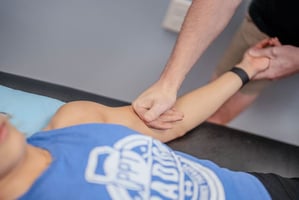Physical therapy is essential for maintaining peak health and athletic performance. At Paradigm...
Preventative Physical Therapy: Your Secret Weapon for Athletic Longevity
.jpg?width=4048&height=3036&name=pexels-ajaybhargavguduru-863988%20(1).jpg) In the world of sports, the adage “an ounce of prevention is worth a pound of cure” rings especially true. Athletes are always pushing their bodies to the limit, striving for peak performance, but this relentless pursuit often comes at a cost. Injuries are a common, sometimes inevitable, part of an athlete's journey. However, many injuries can be prevented with the right approach to physical care. Enter preventative physical therapy—a proactive strategy that not only helps athletes avoid injury but also enhances their overall performance.
In the world of sports, the adage “an ounce of prevention is worth a pound of cure” rings especially true. Athletes are always pushing their bodies to the limit, striving for peak performance, but this relentless pursuit often comes at a cost. Injuries are a common, sometimes inevitable, part of an athlete's journey. However, many injuries can be prevented with the right approach to physical care. Enter preventative physical therapy—a proactive strategy that not only helps athletes avoid injury but also enhances their overall performance.
In this post, we’ll explore how preventative physical therapy works, why it’s essential for athletes of all levels, and how it can keep you in the game longer and stronger.
The Unseen Risk: Why Athletes Need Preventative Care
Whether you're a weekend warrior, a seasoned marathoner, or a professional athlete, your body is your most valuable asset. Every run, jump, or lift subjects your muscles, joints, and tendons to significant stress. While training helps you grow stronger, it also increases the risk of overuse injuries, muscle imbalances, and other performance-hindering issues.
Preventative physical therapy addresses these concerns before they become problems. By regularly assessing your body’s biomechanics, identifying potential weaknesses, and correcting movement patterns, physical therapists can help you avoid the common pitfalls that lead to injury.
Common Injuries in Athletes
Athletes are prone to a range of injuries, many of which can be mitigated with preventative care:
- Sprains and Strains: These occur when muscles or ligaments are overstretched or torn, often due to sudden movements or overuse.
- Tendinitis: Inflammation of the tendons, commonly seen in the shoulders, elbows, and knees.
- Stress Fractures: Small cracks in the bone caused by repetitive force, often seen in runners and jumpers.
- Patellofemoral Pain Syndrome: Also known as “runner’s knee,” this is a common condition where the cartilage under the kneecap becomes irritated.
- Shin Splints: Pain along the shin bone, usually due to overuse, especially in runners.
Each of these injuries can sideline an athlete for weeks or even months. But with preventative physical therapy, many of these issues can be avoided altogether.
How Preventative Physical Therapy Works
Preventative physical therapy is not just about addressing injuries after they occurs about being proactive in your approach to training and recovery. Here’s how it works:
- Comprehensive Assessment
- A preventative physical therapy program starts with a thorough assessment. This isn’t just about looking for current injuries; it’s about identifying potential risks. Physical therapists assess your movement patterns, flexibility, strength, and joint mobility. They may use tools like gait analysis, functional movement screenings, or sports-specific assessments to understand how your body moves and where it might be vulnerable.
- Customized Exercise Programs
- Based on the assessment, one of our Doctors of Physical Therapy will develop a tailored exercise program designed to address any imbalances or weaknesses. This might include strengthening exercises for underused muscles, stretches to improve flexibility, and drills to correct improper movement patterns. The goal is to create a well-balanced body that can withstand the rigors of your sport.
- Education and Technique Correction
- One of the most critical aspects of preventative care is education. Athletes are often unaware of the impact that poor technique can have on their bodies. Our performance physical therapists will not only correct your form but also educate you on the importance of proper technique during training and competition. This education extends to other aspects of your athletic life, such as the importance of proper warm-ups, cool-downs, and recovery strategies.
- Ongoing Monitoring and Adjustment
- Preventative physical therapy isn’t a one-and-done solution. As you progress in your sport, your body changes, and your physical therapy program should adapt accordingly. Regular check-ins with your physical therapist ensure that your program evolves with your needs, continuously addressing new challenges and preventing injuries.
The Benefits of Preventative Physical Therapy
The benefits of incorporating preventative physical therapy into your athletic routine are numerous:
- Injury Prevention
- The most obvious benefit is injury prevention. By addressing weaknesses, improving flexibility, and ensuring proper technique, preventative physical therapy significantly reduces your risk of common sports injuries. This means fewer missed games, training sessions, and competitions.
- Enhanced Performance
- A body that is well-balanced, strong, and flexible performs better. Preventative physical therapy helps optimize your biomechanics, allowing you to move more efficiently and effectively. Whether it’s shaving seconds off your time, jumping higher, or lifting heavier, a well-conditioned body will perform at a higher level.
- Faster Recovery
- Even with the best preventative care, injuries can still happen. However, athletes who engage in regular preventative physical therapy often recover faster. A body that is already in peak condition is better equipped to heal and bounce back from injuries.
- Longer Athletic Career
- For many athletes, the goal is longevity in their sport. Preventative physical therapy helps extend your athletic career by keeping your body in top shape. By avoiding the cumulative damage that can result from untreated injuries and improper technique, you can enjoy your sport for many more years.
Case Studies: Success Stories from the Field
Preventative physical therapy has countless success stories. Consider professional athletes who attribute their long careers to consistent preventative care. For example, basketball players who work with physical therapists to improve their movement patterns, reducing the risk of knee injuries, or marathon runners who incorporate regular mobility work to prevent shin splints and stress fractures.
Even at the amateur level, athletes who engage in preventative physical therapy often find that they can train harder, recover faster, and avoid the injuries that sideline their peers.
Conclusion: Keeping Athletes in Peak Condition with Preventative Physical Therapy
Athletes are driven to push their limits, but with that drive comes the risk of injury. Preventative physical therapy offers a proactive solution, helping you stay in the game, perform at your best, and enjoy a long, healthy athletic career. By addressing potential issues before they become problems, physical therapists play a crucial role in keeping athletes strong, flexible, and injury-free.
So, if you’re serious about your sport, it’s time to take your training to the next level with preventative physical therapy. Don’t wait until you’re sidelined by an injury—start your preventative care today and stay ahead of the game.




